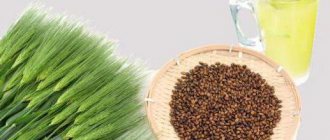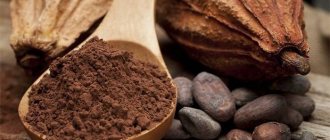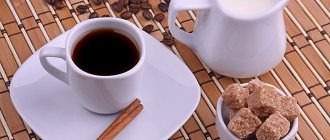What does the drink consist of?
According to manufacturers, this type of coffee contains coffee beans, milk or cream, and sugar. True, the shelf life of natural dairy products is quite short. Therefore, instead of them, vegetable cream is used containing the following components:
- coconut or palm oil;
- glucose syrup;
- acidity regulators;
- milk protein;
- flavor enhancers;
- emulsifiers;
- stabilizers.
The most expensive component is the coffee fruit. Naturally, manufacturers save on them in every possible way and use the cheapest robusta beans. Often they are completely replaced with barley grains, acorns or chicory.
Often, excessive amounts of granulated sugar are added to the bags. Due to this, it is possible to hide the taste of a low-quality product. The drink turns out to be very sweet and cloying.
The composition may also include additives such as liqueur, coconut, chocolate or caramel. These components are also created artificially. They have nothing to do with natural products.
In 100 g of drink, the protein content is 2.35 g, fat 10.4 g, and carbohydrates 69.72 g. The calorie content of 3 in 1 coffee is quite large - 358.25 kcal.
Benefit or harm
If you drink this drink occasionally, no harm will be done to the body. True, the sublimate will not bring any benefit either. Positive changes can only be observed if the composition contains natural grains. Thanks to their presence, you will be able to get a boost of energy.
- How many calories are in coffee - calculating the calorie content of different types of drink
Three-in-one coffee will cause harm if consumed systematically. This may cause the following problems:
- increase in body weight. Due to high sugar content;
- disruption of the nervous system, gastrointestinal tract;
- removal of calcium from the body;
- heart problems.
Separately, it should be said about the dangers of this sublimate during pregnancy. It is not advisable for pregnant women to drink coffee at all.
Caffeine can cause miscarriage and provoke abnormalities in the development of the child. Expectant mothers should completely avoid the 3-in-1 drink. It contains a lot of chemicals and a lot of sugar. If you really can’t give up coffee, it is recommended to give preference to a natural product.
It is possible to reduce the negative impact of a coffee drink. In this case, you should adhere to the following recommendations:
- add a little natural milk to the composition. Thanks to this, it will be possible to compensate for the lack of calcium;
- Avoid using sublimate on an empty stomach. It is best to drink it half an hour after eating;
- after each cup of drink, drink at least a glass of plain water;
- do not abuse coffee products. It is strictly forbidden to drink it too often.
The benefits and harms of 3 in 1 coffee mixes
Summing up and analyzing the composition of products like MacCoffee, whose name has become a household name for instant drinks, we can draw ambiguous conclusions. There are brands that offer quality products - these are LaFesta, Nescafe, Jacobs and some expensive foreign analogues. But even such lines have drawbacks: unbalanced taste, bitterness in coffee, low quality creamy mass.
Other products cause more criticism in terms of composition - this is a 3 in 1 coffee mix from McCoffee, Petrovskaya Sloboda, Jockey and lesser-known brands. Such mixtures contain a low content of natural grains and low-quality cream.
Decent instant coffee does not cause any harm to the body if you drink it in moderation. Sometimes it is useful to replace strong tea leaves with such a mixture in order to protect your heart. An additional argument in favor is that the calorie content of 3-in-1 coffee blends is significantly lower than that of dessert drinks with syrups from StarBucks and similar coffee shops.
It is worth paying attention to the content of trans fats (palm fractions and similar components), which are harmful to blood vessels and can disrupt metabolism. This product significantly increases the calorie content of a serving. Excess sugar can also be harmful. Sugary portions provoke surges in blood glucose, which can lead to dependence on the drink. And more than 2-3 cups of 3in1 per day are extra calories.
Addiction and abuse of a “bad” three-in-one drink can provoke digestive problems, headaches, deterioration of blood composition, and as a result – weakness, malaise, acne rash, dulling of cognitive processes. Moderate consumption will not have a negative effect on the body.
Cooking rules
Coffee in 3-in-1 bags has gained great popularity due to its ease of preparation. You need to do the following:
- Open the package and pour its contents into a cup.
- Pour boiling water into the container.
- Stir the resulting liquid with a spoon.
After this, the coffee is ready to drink. Such actions can be performed in any conditions where there is boiling water. Therefore, 3-in-1 bags are often taken to work or on a trip.
Three-in-one coffee is very popular in all corners of the planet. Its main advantage is the speed and ease of preparation. True, no more positive qualities are noted. The product contains many chemical elements, and coffee beans are often completely absent. True, sublimate lovers are not embarrassed by this fact; they continue to drink it day after day. After all, it only takes a few seconds to prepare, but the end result is a tasty, sweet drink.
Composition of coffee bags
Three-in-one coffee in bags is preferred by lovers of sweet drinks. Not everyone thinks about the natural composition of the product. The main component of the contents in the bags is sugar. In most products it is more than 50%. Therefore, this product has a very sweet taste. Some manufacturers add sodium cyclamate and acesulfame potassium, increasing its cloying properties. The components help hide the taste of low-quality coffee. Cheap products add the most sugar and sweeteners.
Another ingredient is cream. Dry milk components cannot be stored for a long time, so ingredients of plant origin rather than natural origin are added to the product. They have a similar taste and aroma of real cream. For “3 in 1 coffee” the components are made from vegetable fats. Includes:
- palm or coconut oil;
- glucose syrup;
- stabilizers;
- sodium caseinate;
- emulsifiers;
- flavorings;
- anti-caking agent;
- salt.
Packaged coffee has a very sweet taste
- Coffee 3 in 1: calorie content of one bag and chemical composition of the product. How harmful is it to use
The most interesting thing is how much coffee is in the “3 in 1” coffee. Oddly enough, there is the least amount of it in the drink. This is due to the high cost of grains. The caffeine content in the stick is from 0.3% to 0.5% . Cheap products may not have this component. Instead, manufacturers add chicory, crushed barley grains or nuts. The use of substitutes reduces the cost of the product. The packaging of the drink must indicate that there is no coffee in the package.
In addition to the listed ingredients, you can see flavorings in the composition. Components may vary slightly between manufacturers.
Composition of the drink
It would do well for lovers of surrogate products to know that the composition of 3 in 1 coffee - Nescafe or Maccoffee - includes the following components:
- A glucose-based syrup that sharply increases blood sugar levels, causing the pancreas to actively produce digestive juices and insulin. After several years of regular consumption of 3-in-1 coffee, the caloric content of which is excessively high in 1 bag, you can develop pancreatitis or cholecystitis.
- Palm oil, which is beneficial only in its raw form and only to healthy people leading an active lifestyle. Refined, which is present in the 3 in 1 composition, is poorly digested and deposited inside the vessels.
- A milk protein of artificial origin, which caused a scandal in China and several directors of companies producing this product were executed because children died. Melamine was added to milk, supposedly to improve its characteristics. The substance can cause kidney failure.
- Acidity regulators based on potassium phosphate are used to maintain the color of the powder and promote its friability.
- Stabilizers and emulsifiers - sodium citrate, sodium polyphosphate and other chemical compounds - are not very toxic, but only in acceptable quantities. The problem is that few manufacturers adhere to these standards.
As a result of chemical analysis, you can think about whether three-in-one coffee in bags is harmful or not, which brand to choose to maintain health, how many times a day to drink.
Dry cream - what is it?
Until a certain point, manufacturers used natural milk powder. But soon its use became unprofitable, since milk protein quickly deteriorates and cannot be stored for a long time. It was replaced with dry palm powder, which immediately affected the taste of the drink as a whole.
The advantage is only for manufacturers, since such a product is cheaper. Buyers only experience harm when drinking 3-in-1 coffee.
The calorie content of one bag of 3 in 1 coffee when using dry vegetable creamer is less than when adding milk from any manufacturer - McCoffee, Jacobs, Nescafe, Nestlé.
Instant coffee - how it is produced
To understand the composition of McCoffee or Nescafe 3 in 1 bags, you need to know the technology for producing instant coffee. First, the ground grains are brewed with boiling water on an industrial scale, then all the liquid is removed, and the remaining substances are formed into granules or remain in powder form. It is clear that with this technology, few aromatic substances reach the consumer; the taste has to be enhanced by adding chemicals.
An interesting fact is that some bags do not contain coffee at all - it is replaced with nut kernels, acorns, chestnuts, and chicory root. Usually, “coffee” is written on the label, and the actual composition of the powder is written on the back in small print.
There is no need to talk about any vigor after drinking the drink. People who are contraindicated for caffeine can drink this drink. Those who want to buy coffee should read the ingredients so as not to feel deceived.
Supplements – natural or not
3-in-1 coffee bags often contain various additives - caramel, rum, cognac, nutmeg, vanilla. Studies conducted in chemical laboratories gave a clear answer - the additives are not real. This marketing ploy was necessary to increase sales, and chemicals were added to the composition.
Calorie content of coffee with sugar
For lovers of sweet coffee, you can calculate the calorie content of the drink when adding sugar.
If you prefer granulated sugar, then a teaspoon contains 6 grams. Which means it's 24 kcal.
If a cube of refined sugar weighs from 5 to 10 grams, then it contains from 20 to 40 kcal.
Brown or cane sugar is considered sweeter than regular sugar but contains slightly more calories. There are 25 kcal in a teaspoon.
- Calorie content of coffee without sugar
When adding a teaspoon of honey to coffee, the calorie content will increase to 67 kcal.
If you drink coffee only with sugar, then the calorie content of the entire drink will be equal to the calorie content of sugar. It turns out that if you want to regulate the amount of calories you take in, change the amount of sugar you add.
Do you like to drink coffee and have come to the conclusion that it would be nice to change your coffee maker? Find out how to choose a coffee maker for your home on our website.
Find out about helba chelation here, it might be useful to you.
Harm and benefits of powdered coffee
Sweet powdered coffee in bags is very different from ground beans with natural cream or milk. In this regard, commercial coffee drinks have certain harms and benefits. Due to the small amount of caffeine, the product is not suitable for those who want to perk up. Another drawback is the harmful composition. Particularly dangerous:
- Large amounts of sugar. Provokes the development of diabetes mellitus. For people with this disease, sweets are contraindicated.
- Vegetable cream. Trans fats are harmful to the body. They increase cholesterol levels and slow down metabolism. The processes are fraught with the appearance of obesity and cardiovascular diseases.
- Supplements Emulsifiers and stabilizers may cause an allergic reaction to certain components.
Regular consumption of packaged coffee drinks has a negative impact on human health. If you drink it occasionally, without replacing natural coffee with it, there will be no serious damage to your health. Expectant mothers are wondering whether 3-in-1 coffee can be consumed during pregnancy. It is contraindicated for them due to its chemical composition and large amounts of glucose. The same applies to children and the elderly.
There are several manufacturers of 3-in-1 drink on the market
The powdered drink also has benefits. The coffee content in the products is minimal. Suitable for all those who cannot drink caffeine - people with hypertension (high blood pressure), heart disease, prone to tachycardia.
Composition of instant coffee brand 3 in 1
On each bag of famous brands Nescafe coffee mix 3 in 1, Jacobs, McCoffee and other similar brands you can read the composition. It is broadly similar and includes the components of coffee, milk or cream and sugar. But not every manufacturer is ready to honestly state the composition of a product that is labeled as three in one.
About coffee
Responsible brands actually include real coffee in their bags. Thus, consumer surveillance researchers found that the Nescafe brand uses high-quality Arabica beans, so their coffee has a subtle, pronounced aroma. Jacobs and some foreign import brands also offer consumers good instant coffee.
Medium and low-quality brands usually save on the coffee component by including cheap robusta in the drink and mixing it with coffee substitutes:
- cereal powders;
- chicory;
- chestnuts and acorns.
This is why three-in-one coffee in bags often tastes unpleasantly bitter.
A small proportion of coffee (as in MacCoffee or Russian Coffee House) means that the drink contains almost no caffeine, although some brands add a synthetic analogue to the 3in1 so that the resulting brew gives vigor. The powders used are harmless, but they do not bring any benefit to the body.
About cream
The picture is worse with cream. Due to the fact that natural dairy products have a very short shelf life, plant analogues are used in three-in-one coffee.
Powdered cream or milk most often contains neither milk protein nor fat or contains a synthetic substrate. They are mainly made from palm oil, glucose or corn syrup and contain emulsifiers, stabilizers and anti-caking agents that are harmful to consume in large quantities.
Studies have shown that some cheap brands (BonCoffee and the like) significantly exceed the norm for the content of trans fats in 3 in 1 coffee. Such indicators are already dangerous for the cardiovascular system and cholesterol levels; such a drink should not be drunk by diabetics, overweight people and atherosclerosis.
It is worth saying that the taste of vegetable cream, to put it mildly, leaves much to be desired. Even the most fragrant Arabica, as in Nescafe 3in1, can be spoiled by an “inedible” shade of surrogate fat.
About sugar and flavorings
To hide all taste defects, manufacturers of 3in1 instant coffee put an excess amount of sugar and sweeteners into the bags, often combining such components. There are no labels indicating that the product is a dietary product.
Often you come across three-in-one coffee lines with flavors: caramel, vanilla, hazelnut, amaretto and others. They also have nothing in common with natural products - they are just synthetic flavors. Such instant drinks do not always taste good, although there are pleasant exceptions.
Types of coffee-based drinks
Let's consider the calorie content of such favorite drinks as latte, cappuccino and iced glass.
A classic cappuccino consists of one third coffee. Another third of the drink is hot milk and the remaining part is milk foam.
The calorie content of a two hundred gram cup of cappuccino will be approximately 60 kcal.
A latte also consists of espresso coffee and milk, but the ratio of ingredients in this drink is different. For one part coffee you need to take three parts frothed milk.
The calorie content of 200 g of latte is therefore slightly higher than a cappuccino and amounts to 64 kcal.
Glasse is perhaps the most high-calorie milk-containing coffee drink. They prefer to drink it in the summer, since the ice cream is based on espresso and ice cream.
The calorie content of a cup of classic glass is more than 150 kcal.
To date, scientists have come to a consensus about the benefits of coffee.
It is an undeniable fact that to cause the least harm to the body, it is better to use natural ingredients.
Popular manufacturers
“3 in 1” coffee sticks are produced by both large brands and very little-known ones. In their assortment you can find instant coffee with different flavoring additives. The most popular manufacturers include:
- Nescafe. Made from Arabica beans. The company produces drinks of different strengths: “Classic”, “Strong” and “Soft”. "Caramel" was recently released. Vegetable cream is used. The share of sugar is 60%. There is a sweetener - sodium cyclomate. It is noteworthy that Nescafe has a low content of trans fats.
- Jacobs. “3 in 1” sticks are available in different flavors – “Classic”, “Strong”, “Soft”. New is the Jacobs 3 in 1 Monarch. The package no longer contains powder, but whole granules with vegetable cream. Sugar – 40%. Some trans fats. There is a sweetener - acesulfame potassium.
- "Petrovskaya Sloboda" Many consumers choose Russian-made products. The assortment includes different flavors of the drink in bags - “Classic”, “Strong”, “Almond”, “Caramel”, “Hazelnut”, “Condensed milk”. Vegetable cream and 70% sugar are used, but there are no sweeteners. Small amount of trans fats.
- "Golden Eagle" The Malaysian company was one of the first to supply instant coffee to the Russian market (1994). The assortment includes only a few flavors - “Classic” and “Supreme”. The product contains a large amount of sugar and the sweetener maltodextrin. “Golden Eagle” is too cloying, there is no bright coffee taste.
- Vietnamese coffee 3 in 1 “G7”. A lesser-known, but quickly gaining popularity, manufacturer of coffee drinks in bags. The composition differs from previous companies for the better. Vegetable cream based on coconut oil, not palm oil. Molasses is present, but sugar is not the main component. The package contains the most freeze-dried coffee. Caffeine – 0.25%. The drink is very invigorating.
These manufacturers of coffee products are the most popular on the Russian market. A varied assortment helps you choose a drink to suit your taste, but they all have a similar composition. The exception is Vietnamese coffee “G7”. The product has better ingredients, less sugar and more caffeine.
You are using an outdated browser
Old browser versions can put your security at risk. In addition, there is a high probability of errors in the operation of the site.
To take advantage of all the features of the Utkonos online hypermarket, you need to install a modern browser. It's simple and fast.
Popular brands that produce 3 in 1 coffee
Russian brand Petrovskaya Sloboda The high popularity of 3-in-1 bags allowed coffee producers to include such a drink in their product line. Some companies specialize only in instant forms, others produce absolutely all types - from grain to packaged. In Russia, the most popular brands have deservedly become:
- McCoffee. A true leader in the production of ground coffee. Reasonable prices and memorable advertising earned the brand the love of Russians. The brand's drinks are rich thanks to the careful processing of grains collected in Asia. The correct recipe and different degrees of roasting made it possible to create a tasty and aromatic 3 in 1 instant coffee. The line includes drinks marked “soft”, “classic”, “original”, “strong”, also available in this format: latte, cappuccino and caramel latte . The cost per bag starts from 12 rubles.
- Arabica beans in the composition allow you to get a rich, rich taste and high strength of coffee. Drinks from this brand dissolve perfectly even in warm water, leaving no sediment. The choice of flavors is huge: from “classic” and “soft” to “coffee charge” and “strong”; for gourmets there is coffee with creamy and caramel aroma. The price per stick starts at 10 rubles.
- An Asian company that introduced its products to the Russian market more than 20 years ago. The use of cheap flavorings, chicory and other substitutes for natural grains gives the drink a strong aroma and bitter taste, so its sugar content is higher than others. The granules do not dissolve well and leave sediment at the bottom of the cup. The line includes coffee of different strengths.
One of the most common brands on the post-Soviet coffee market. It is fundamentally different from other drinks of the Cappuccino di Torino brand, it has an excellent taste and aroma, a delicate coffee foam forms on the surface, and a nice bonus is the included bag of grated chocolate. If a standard 3-in-1 bag costs about 9 rubles, then the new exquisite dessert has more weight and a price of 25 rubles and more.
- Petrovskaya Sloboda. A Russian brand that produces one of the best 3-in-1 coffees. The harmonious taste and rich aroma are enjoyed by the residents of our country. A special feature of the brand is a rich collection of drinks: there are classic ones of different strengths, and gourmet ones, with the aroma of hazelnut, condensed milk, almonds, caramel, coconut or ice cream. The price is more than affordable - for a bright bag you will have to pay about 12 rubles.
- Jockey. The brand, which has long been known throughout the world, recently launched a 3-in-1 drink format on the market, which is not inferior in quality to more expensive and famous competitors. Unfortunately, there are only three coffee options in the line so far: “soft,” “delicate,” and “strong,” which can be purchased for an average of 9 rubles.
The Jockey brand has launched the production of three varieties of coffee in bags. The 3-in-1 coffee format is very popular all over the world. Its main and, perhaps, only indisputable advantage is quick and simple preparation. The product contains low quality coffee raw materials or even its substitutes. Vegetable fats can also hardly be called healthy, and their calorie content is high. However, lovers of instant coffee continue to drink it with pleasure, because it is prepared in seconds, and the taste of the drink is sweet and pleasant.
How to choose a good product
In order not to poison your body with low-quality mixtures, the first thing you should focus on is the taste of coffee drinks. If the coffee mix is bitter, leaves an unpleasant film in the mouth, is cloying or has a strong flavor, you should avoid such a product.
Secondly, it is worth reading the composition and calorie content of McCoffee, Nescafe and their brothers. It’s enough to work hard once and remember which brands are acceptable and which ones should be avoided.
- If “coffee” is listed at the end of the package, it means there is virtually no natural grain ingredient.
- When the calorie content of a 20-25 g pack is 100 kcal or more, such a drink will not be beneficial due to the increased sugar and fat content.
- If the indicated shelf life is no more than a year, and the price of the product is not the lowest - it uses real dry cream, such a pack will please the body.
Each region has its own local brands like MacCoffee. You can try such a product, because you often come across decent samples. If the composition and taste of the drink are acceptable, you can sometimes treat yourself to a light instant cocktail.
How many calories are in a latte?
How many calories are in coffee with milk?
An additive in the form of milk or cream only gives the coffee drink its characteristic softness of taste. However, milk in coffee usually means extra calories. Exactly how much depends on the fat content of the milk
. So, for example, 100 grams of milk with a fat content of 1 percent contains 42 kilocalories; a product with a fat content of 2.5 percent already contains 54 kilocalories.
How many calories are in one serving of milk added to coffee?
The answer to this question directly depends on how much milk you add to your coffee. If it's a couple of teaspoons
(one such spoon is 5 grams of milk), then you add literally 5 kilocalories of nutritional value to the finished drink.
In other words, a cup of drink (for example, espresso) with two teaspoons of milk contains approximately 22 kilocalories. Add two tablespoons of sugar there - you get a total of about 68 kilocalories
. A cup of instant coffee without sugar and with milk in approximately the same proportion - about 10 kilocalories; with sugar – 56 kilocalories.
By the way, why exactly two spoons? We took the standard packaging of portioned coffee cream as a basis - it is usually packaged in 10 gram quantities
. The calorie content of such cream is much higher - 10 percent cream contains 118 kilocalories per 100 grams of product.
- Coffee
This section presents the calorie content of 3-in-1 coffee in various preparation options, as well as the content of proteins, fats and carbohydrates. All data is provided per 100 grams of the finished product. To find out the content of BZHUK in a serving (cup), enter the required amount of product into the calculator.
How many grams of coffee are in a teaspoon and a tablespoon?
In cases where several servings of coffee are prepared at a time, for example in a coffee maker with a large flask, it is more convenient to measure the grind with a tablespoon. And for espresso or Turkish coffee, of course, it’s more convenient to take a teaspoon. So remember this:
- One level tablespoon of ground coffee is approximately 12 grams. With a slide - 17 grams.
- A level teaspoon of ground coffee – 3-4 grams. With a slide - 6 grams.
- A level teaspoon of freeze-dried instant coffee – 2 grams. With a slide - 2.5 grams.
- A level teaspoon of instant coffee powder – 3 grams. With a slide - 3.5 grams.
Calorie content of all coffee in a row:
By clicking on the “Submit” button, I consent to the processing of personal data.
Product 1 —>
Coffee 3 in 1 Irish
Specify the quantity:gmlstactarProteinsFatsCarbohydratesKcal
1.Coffee 3 in 1 Irish
| Specify quantity: | Squirrels | Fats | Carbohydrates | Kcalories |
| G | ml | PC | stack | tar |
Product 2 —>
Coffee Maccoffe 3 in 1
Specify the quantity:gmlstactarProteinsFatsCarbohydratesKcal
There are many coffee lovers among us. Some people prefer to cheer themselves up in the morning with a cup of freshly ground and aromatic coffee brewed in a Turk. Some people prefer to treat themselves to a large cup of cappuccino or latte at lunch. During the working day, many of us prefer to speed up the process of preparing our favorite drink using instant coffee.
Is coffee healthy? In small quantities, of course.
Many coffee lovers are concerned about the question: how many calories enter our body when drinking this drink daily?
The scientific experiments carried out can only please all coffee lovers - its calorie content is very low.
So, 100 grams of a drink made from ground coffee contains only 1 kilocalorie.
The calorie content of coffee can change upward if the coffee beans have been over-roasted or stored for too long . In this case, more fatty oils are released.
The popularity of instant coffee is due to the speed of its preparation . After all, what’s simpler: pour it into a cup, add sugar, milk if desired, fill it with water - and now the aromatic drink is ready.
The calorie content of 100 grams of dry instant coffee is 94 kcal. A prepared cup of such a drink will contain approximately 2-3 calories.
Creative manufacturers went even further: they came up with the idea of producing portioned coffee in bags designed for one cup, already with sugar and milk .
Here the cooking process is even faster: pour out the contents of the bag and add the required amount of water.
Let's calculate the calorie content of the finished drink. To do this, consider the number of calories in each ingredient:
- sugar – 38 kcal;
- coffee – approximately 1 kcal;
- cream – 31 kcal.
The calorie content of a 3-in-1 coffee bag is 70 kcal.
You just need to take into account that the coffee and cream in this drink are not natural, and this is not in favor of its use. One cannot count on much benefit from such a drink.
Is three-in-one coffee harmful?
Of course, 3 in 1 coffee cannot replace a natural drink either in taste or in its effect on the body. The packaged analogue is more convenient both in transportation and in preparation, but it is not recommended to drink it every day. Don't forget that it contains a lot of sugar and trans fats. At the same time, doctors claim that consuming high-quality semi-finished products in reasonable quantities will not cause significant harm to health. As they say, everything is good in moderation.
Milkshake with coffee
Coffee is a tonic drink that energizes the body.
At the same time, the packaged analogue contains it in minimal quantities and has virtually no effect on alertness.
But it contains much more calories and may well contribute to weight gain. For example, one serving of McCoffee contains 1440 kcal.
There are practically no contraindications to this drink. Of course, you should use instant coffee with caution if you have diabetes. Otherwise there are no restrictions. There is no clear answer as to whether it is possible to drink it during pregnancy. As a rule, doctors recommend limiting the consumption of natural coffee, as it increases heart rate. At the same time, the soluble analogue contains caffeine in small doses, so it definitely won’t harm pregnant women. However, the presence of artificial additives in the composition is alarming and it is better to reduce the consumption of this drink to a minimum.
Coffee with milk and sugar (with cream)
To soften the taste, milk or cream is often added to natural coffee.
Cream is fattier than milk and will add even more calories to your coffee. For comparison: 100 g of milk with 3.5% fat contains about 63 kcal, and the same amount of cream contains from 220 to 360 kcal.
Then it all depends on the amount of milk or cream you add to your cup. If you prepare yourself a drink by mixing coffee and milk (100 ml each) in equal proportions and without adding sugar, then you will get a delicious, aromatic drink with a calorie content of 63 kcal.
100 g of coffee with milk and sugar contains approximately 90 kcal, and with cream – 270 kcal or more.
If you prefer to use cream of plant origin rather than animal origin, then add:
when using 1 tablespoon of dry cream – 40-45 kcal, and 1 tablespoon of drinking cream – 20-35 kcal.
Let's look into history
There are different opinions about who and when came up with the idea of combining instant coffee and dry cream in one package. But everyone agrees that they developed this type of coffee solely for the convenience of consumers. This product stores well, is easy and quick to prepare, and can always be taken with you.
The technology for making instant coffee was first discussed at the end of the 19th century. But this idea gained popularity only in the next century, when the speed of life itself increased. Many people could no longer waste time on a meal and a cup of coffee by the fireplace.
Instant coffee began to be produced on an industrial scale in 1909. Soon the market demanded portioned bags. To make the process of preparing the drink even easier for the buyer, sugar was immediately added to coffee bags. The next step was obvious: coffee with cream. Cream reduces the bitterness of the drink and makes its taste softer. But how to add a dairy product to a dry semi-finished product?
Types of coffee-based drinks
Let's consider the calorie content of such favorite drinks as latte, cappuccino and iced glass.
A classic cappuccino consists of one third coffee. Another third of the drink is hot milk and the remaining part is milk foam.
The calorie content of a two hundred gram cup of cappuccino will be approximately 60 kcal.
A latte also consists of espresso coffee and milk, but the ratio of ingredients in this drink is different. For one part coffee you need to take three parts frothed milk.
The calorie content of 200 g of latte is therefore slightly higher than a cappuccino and amounts to 64 kcal.
Glasse is perhaps the most high-calorie milk-containing coffee drink. They prefer to drink it in the summer, since the ice cream is based on espresso and ice cream.
The calorie content of a cup of classic glass is more than 150 kcal.
To date, scientists have come to a consensus about the benefits of coffee.











